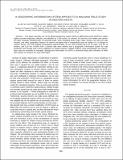| dc.contributor.author | mbok, Maurice; Hightower, Allen W.; Otieno, Richard; Odhiambo, Richard; Oloo, Aggrey J.; Lal, Altaf A.; Nahlen, Bernard L.; Hawley, William A | |
| dc.description.abstract | This paper describes use of the global positioning system (GPS) in differential mode (DGPS) to obtain highly accurate longitudes, latitudes, and altitudes of 1,169 houses, 15 schools, 40 churches, four health care centers, 48 major mosquito breeding sites, 10 borehole wells, seven shopping areas, major roads, streams, the shore of Lake Victoria, and other geographic features of interest associated with a longitudinal study of malaria in 15 villages in western Kenya. The area mapped encompassed approximately 70 km and included 42.0 km of roads, 54.3 km of streams, and 15.0 km of lake shore. Location data were entered into a geographic information system for map production and linkage with various databases for spatial analyses. Spatial analyses using parasitologic and entomologic data are presented as examples. Background information on DGPS is presented along with estimates of effort and expense to produce the map information | en_US |

